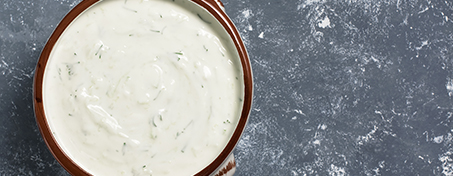Yogurt

Most people associate yogurt with cow’s milk, but it can also be made from goat, sheep, camel and soy milk. Yogurt originated in the Middle East, where the domestication of the cow occurred about 9,000 years ago. It’s likely that yogurt was eaten long before it was recorded in history in about 2000 BC. Modern interest in yogurt began in 1910, when Russian researcher Ilya Metchnikoff reported that Bulgarian peasants, whose diets included a great deal of yogurt, lived to extraordinary ages (Does anyone remember those yogurt commercials from the 70’s?).
Yogurt is a cultured milk product, made by adding “good” bacteria to milk. These “friendly” cultures, L. bulgaricus (named after those long-living Bulgarian peasants) and S. thermophilus, are what give yogurt its special properties. Similar to the making of beer or cheese, yogurt is made by introducing a bacteria culture into milk and allowing time for it to ferment. The result of this process is the creamy texture and distinctive flavor we all know as yogurt.
Many people eat yogurt for its health benefits, because yogurt is more than a delicious, nutritious food. Along with being a good source of protein, calcium, and potassium, yogurt with live, active cultures can help to overcome lactose intolerance, and help to prevent and combat digestive tract infections. Some recent research also indicates the possibility that yogurt can help boost the immune system, lower cholesterol, and has potential in the prevention of certain cancers.
Other yogurt folklore remedies profess the benefits of yogurt for skin disorders from pimples to eczema and psoriasis. Additionally, yogurt has been mentioned in treatments for insomnia, hepatitis and jaundice. Bottom line – yogurt is good food!
At the market
Yogurt is as familiar as milk in the dairy cases of supermarkets everywhere. It is available fresh or frozen and in regular, low-fat, and nonfat varieties.
It is best to choose a type of yogurt and that contains two important live active cultures L. bulgaricus and S. thermophilus.
To remove some of the fat in recipes and add the health benefits of yogurt to foods, substitute plain yogurt for mayo and sour cream in dips, sauces, dressings and more. Here are few ideas:
- Substitute plain yogurt for 1/3 to 1/2 the mayonnaise normally used in tuna, chicken and potato salads.
- Use equal parts sour cream and plain yogurt in your dip recipes to serve with vegetables.
- Try mixing plain yogurt with chili sauce for a simple shrimp dipping sauce.
- Add a dash of garlic powder and some fresh chopped chives to plain yogurt and serve as a topping for baked potatoes. It’s a great substitute for sour cream.
- Add yogurt to your favorite meat marinade. Yogurt is a natural tenderizer and meats cooked in yogurt tend to be juicier.
- Instead of using milk in your pancake and waffle recipes, try half milk and half plain yogurt.
- Switch from to full-fat ice cream to frozen yogurt for desserts.
- Fruit-flavored yogurt in tubes can be frozen and they make a yummy after-school or after- dinner treat.

Creamy Dill Dressing
Try this homemade creamy dill yogurt dressing on cucumbers or serve it with fish (especially awesome with salmon). It can also be used instead of mayonnaise to make unforgettable deviled eggs.
- ½ cup plain yogurt
- ½ cup mayonnaise
- 1 Tbsp chopped chives or scallions
- 1 Tbsp chopped fresh dill
- 1 Tbsp lemon juice
- Salt and pepper, to taste
Directions: Place all of the ingredients in a bowl and mix well until smooth and creamy. Chill until ready to serve.









